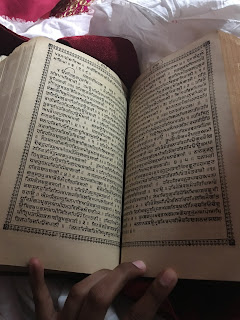Guru Nanak Dev Ji is believed to have spent some time in Nepal in 1516 on their way back from Tibet. Kathmandu’s King Jay Jagat Malla had paid a visit to Guru Nanak Dev Ji during his visit to Benaras for the treatment of his son Jay Prakash Malla (Jagjaya Malla). Eventually, Jay Prakash Malla was cured of his illness by Guru Ji’s blessings and he was invited to visit Nepal. They meditated and discoursed with Sidhs here. The Sikh connection with Nepal developed during the reign of Maharaja Ranjit Singh when the armies of the Sikh and Gorkha courts fought inconclusively in the Kangra region. There are still some descendants from the Sikhs from the Maharaja’s fauj that stayed back here in Nepal. Later, when Maharani Jind Kaur escaped from the British, she came to Nepal and lived here for several years. Accompanying her were Sikhs, many of who settled down in the area around Nepalgunj. She also placed some Mahraj saroops in Nepal. There are six asthans related to Guru Nanak Dev Ji Mahraj in Kathmandu. These asthans also have interesting puratan handwritten Mahraj saroops.
1. Pracheen Udasi Shree Guru Nanak Muth
A large chunk of land donated by the King Jay Jagat Malla to Guruji, including this asthan which is housing a Pipel tree that Mahraj is believed to have meditated under for few months.
Housing a pathar shap Aad Mahraj saroop.
Older Udasis of this Muth.
2. Thapa Thali Kal Mochan Udasi Guru Nanak Akhara
This asthan has a well with Gurbani scribing and some utensils believed to be from Guru Nanak Dev Ji’s time. Baba Sri Chand, the eldest son of Guru Nanak Dev ji, is also believed to have visited Kathmandu, and lived in Thapathali.
Well with Gurbani scribing.
Housing a puratan handwritten Mahraj saroop ( Bhai Banno Ji’s birh).
3. Pashupatinath Mandar
Guru Nanak Dev Ji is believed to have meditated and discoursed with Sidhs here. Housing a puratan handwritten Mahraj saroop that didn’t have bani of Guru Teg Bahadur Ji yet, with a salok in Mool Mantar and Joti Jot dates of Gurus as well as Bhai Gurditta Ji’s.
The saroop bani is until ang 1409 until Bhatt Harbans Ji’s last Swayei if according to current saroop. This saroop had Raag Mala bani at the end eventho it’s not complete of other bania. Could be written by a shardalu of Bhai Gurditta Ji since the saroop has their Joti Jot date.
4. Raaj Rajeshwari asthan
Housing a garden whose flowers are used to perform aarti the Pashupatinath Temple. Unless the Bhatta priest at the temple offers flowers from this garden, the puja cannot be considered duly and ritually complete.
Housing a puratan handwritten Mahraj saroop.
5. Shoba Bhagwati
After Guru Nanak Dev Ji arrived in Kathmandu, they meditated at a location where Singha Durbar presently stands. Later, when the place was engineered for the Durbar, the yogis staying here were relocated to Shobha Bhagwati.


6. Gyaneshwor (Gyan Dhara)
When King Jay Malla came to seek his blessing, Guru Nanak Dev is said to have healed the people of diseases and ended the drought of the place by miraculously bringing out a holy spring from a small stone down the temple. This holy spring is known as Gyan Dhara and continues to flow from a stone sprout located down the flight of stone stairs behind the temple.
Housing a puratan handwritten Mahraj saroop (Bhai Banno Ji birh).
Current Sikhs in Nepal continuing legacy of Guru Nanak Dev Ji by serving langgar near the Muth to the locals every weekend.
All these information is mainly from my experience listening oral history from the locals. Forgive me for any mistakes. Here’s a picture with the Pandit who is the caretaker of Pashupatinath and Gyaneswor asthans.










































